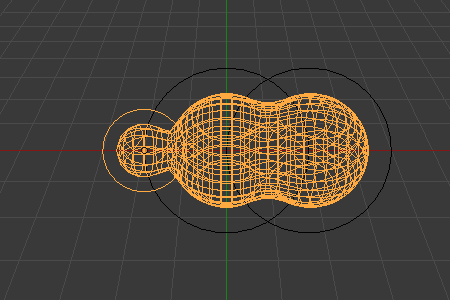Редактирование (editing)¶
Помимо нескольких мета-объектов в одном семействе, вы также можете иметь несколько мета-примитивов в одном объекте (просто добавьте столько, сколько нужно в режиме редактирования). Каждый мета будет отдельным элементом со своей собственной формой, кольцами редактирования (во вьюпорте) и настройками.
Удаление элементов¶
Ссылка
- Горячая клавиша:
X, Delete
Удалить можно только активный элемент, никаких дополнительных опций здесь нет.
Преобразование (conversion)¶
Чтобы преобразовать мета в реальный меш – используйте оператор «Конвертировать (convert)» в объектном режиме.
Семейства объектов¶
„Семейство“ – это способ перегруппировки нескольких мета-объектов, создавая нечто очень похожее на наличие нескольких мета внутри одного объекта.
Оно определяется левой частью имени объекта (той, что перед первой точкой). Помните, имя объекта – это то, что указано в поле „Object Name“, в большинстве панелей, а не поле „имени метасферы“, которое является именем блока метаданных… Например, часть семейства «MetaPlane.001» – это MetaPlane. Каждый из мета-объектов в одном и том же «семействе» взаимодействует с другими, как обсуждается ниже.

Семейство метасфер.¶
Семейство ваших мета контролируется базовым мета-объектом, который идентифицируется именем объекта без точки в нём. Например, если у нас есть три мета с именами MetaThing, MetaThing.001 и MetaThing.round, то „базовым“ мета-объектом будет MetaThing.
Базовый мета-объект определяет основу, разрешение, порог и трансформации. Он также имеет область материала и текстуры. В некотором смысле, базовый мета является „владельцем“ других мета в семействе (т. е. это как если бы другие мета были «включены» или присоединены к базовому).
Подсказка
При работе с несколькими сценами – внимательно относитесь к именованию мета-объектов, чтобы „база“ всегда находилась в той же сцене, что и другие мета-объекты.
Невыполнение этого требования приведёт к поведению, которое будет сбивать с толку (например, к появлению невидимых мета-объектов).
Примеры¶
Рис. Базовая мета-сфера. показывает базовый мета, с выделенным кольцом. Два других объекта мета являются дочерними. Кольца выделения дочерних объектов всегда чёрные, а меш группы оранжевый. Поскольку мета сгруппированы, они образуют единый меш, который всегда можно выделить, выделяя меш любого мета в группе.

Базовая мета-сфера.¶
Например, на рис. Базовая мета-сфера. была выделена только левая сфера (родительская), и вы можете наблюдать, что заодно теперь выделены как родительский меш, так и все дочерние.

Масштабирование „базы“.¶
„Базовый“ мета-объект управляет полигонализацией (структурой меша) для всей группы и, как из этого следует, – также управляет полигонализацией дочерних (не базовых) мета-объектов. Если мы трансформируем базовый мета – изменится полигонализация и дочерних объектов. Однако, если мы трансформируем дочерний объект, полигонализация остальных остаётся неизменной.
Подсказка
Это обсуждение «полигонализации» не означает, что различные меши не деформируются друг к другу или друг от друга (мета-объекты всегда влияют друг на друга в обычном порядке, в рамках одного семейства).
Скорее, это означает, что лежащая в основе структура меша изменяется только при трансформации базового объекта. Например, если вы масштабируете „базу“ – изменяется структура меша и дочерних объектов.
На рис. Масштабирование „базы“. была уменьшена база, что привело к масштабированию структуры меша каждого из дочерних элементов. Как вы можете видеть, разрешение меша дочерних элементов увеличилось, в то время как уменьшился сам базовый мета. Дочерние элементы свой размер не изменили!